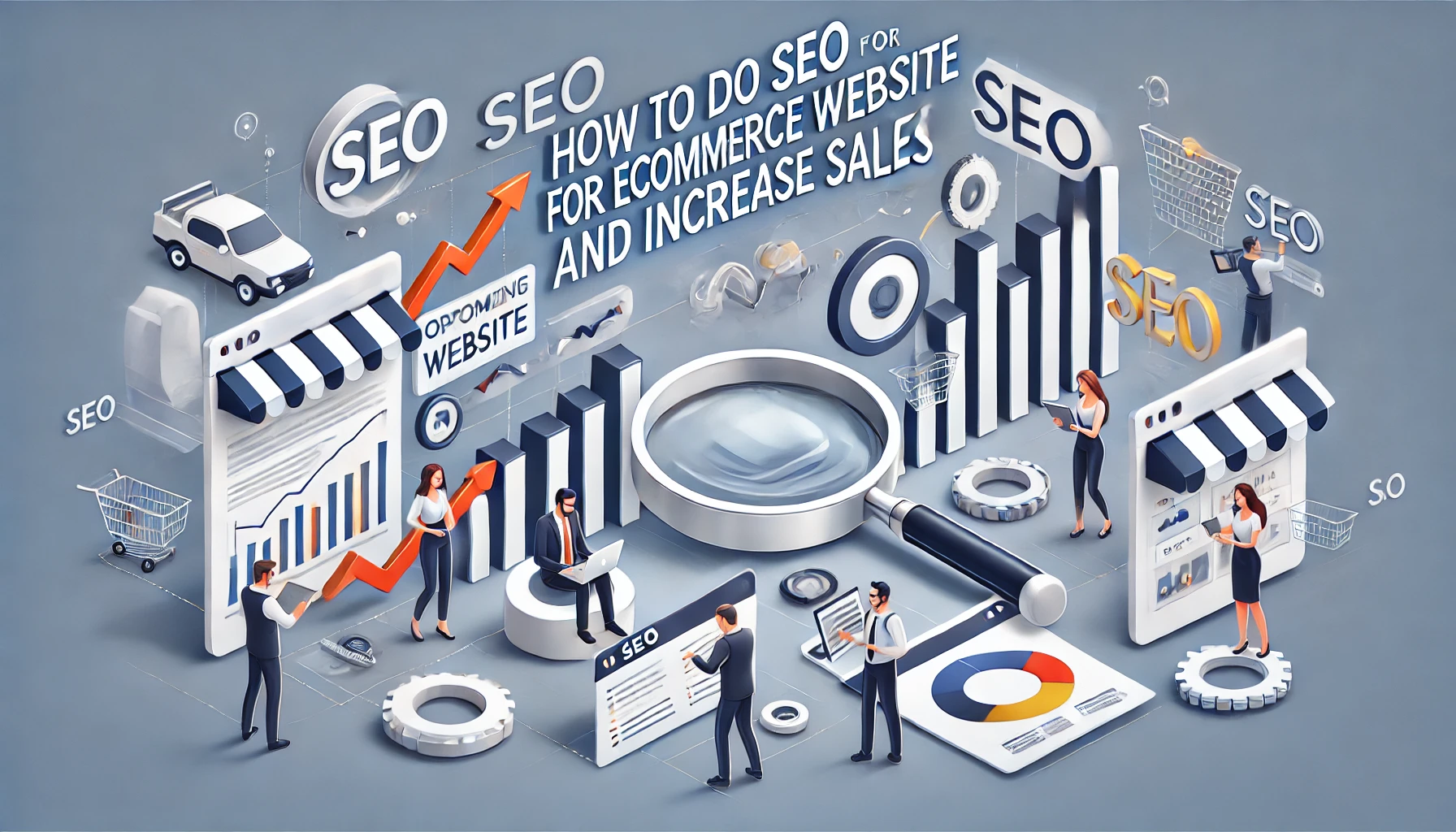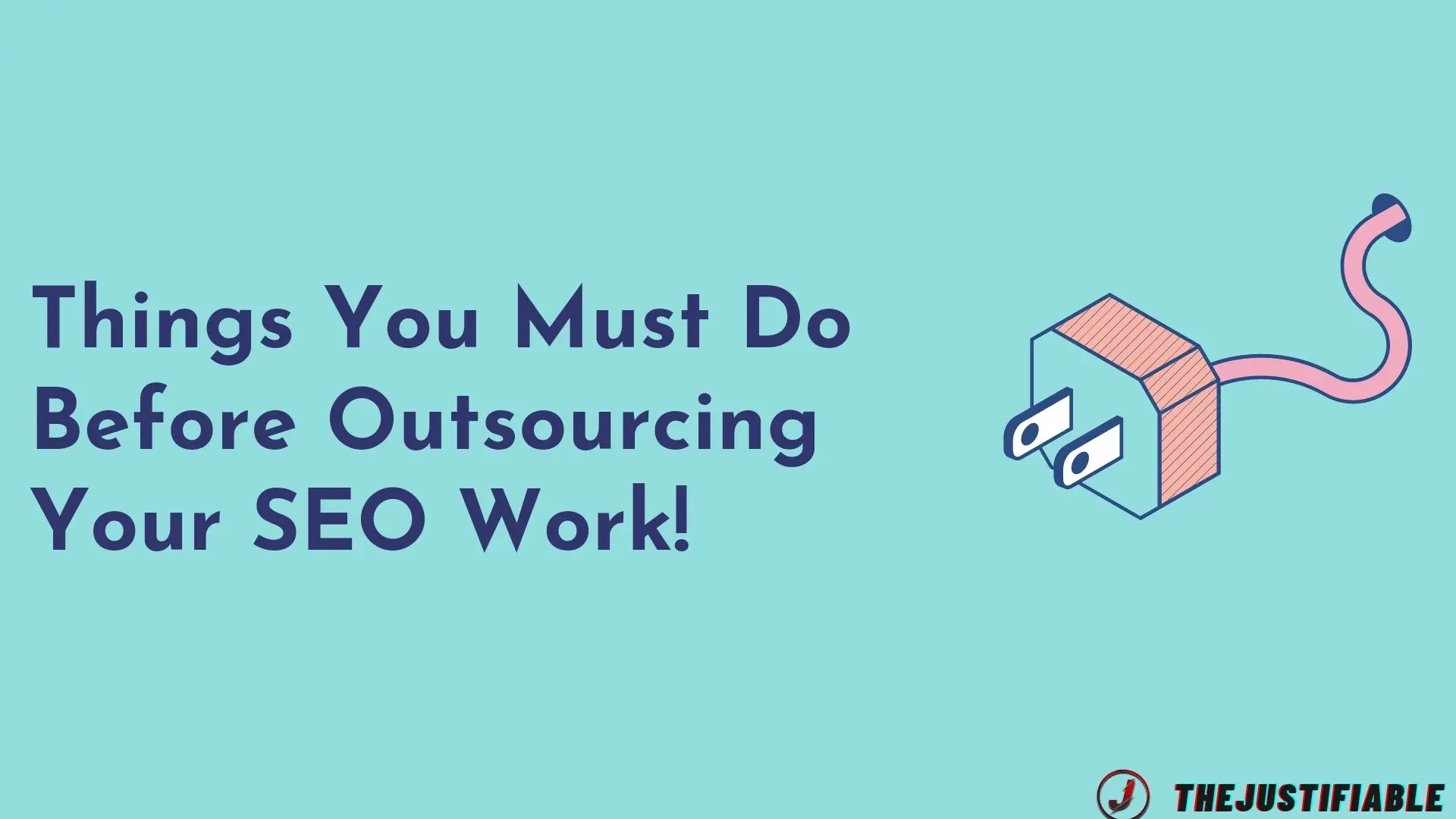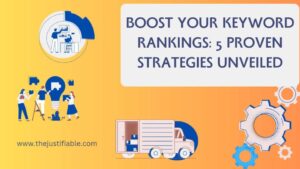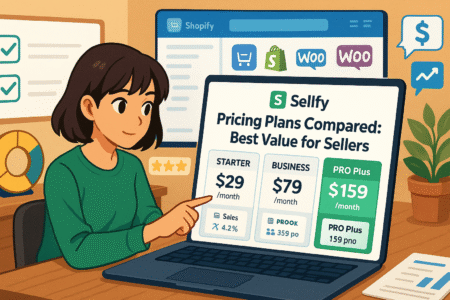Table of Contents
Are you wondering how to do SEO for eCommerce website to increase sales and visibility?
In this article, we’ll explore strategies tailored for optimizing your eCommerce website, driving organic traffic, and boosting conversions. Whether you’re new to SEO or seeking advanced tips, we’ve got you covered.
Understanding SEO for eCommerce Website
Search Engine Optimization (SEO) for eCommerce websites plays a vital role in helping online stores rank higher on search engines, attract targeted customers, and boost sales. Understanding its core principles is essential for a successful eCommerce strategy.
What Is SEO for eCommerce and Why It Matters
SEO for eCommerce involves optimizing your online store to appear prominently in search results. It focuses on product pages, categories, and other website elements, ensuring they align with search intent. This helps customers find you easily.
Effective eCommerce SEO ensures that your products reach the right audience. It matters because most shoppers begin their buying journey with a search query. I suggest viewing SEO as a bridge connecting your products to potential buyers.
Without proper SEO, your products might stay hidden, losing valuable traffic and revenue opportunities. Search engine rankings often determine whether customers choose your store or a competitor’s.
An optimized eCommerce website builds trust and authority. As search engines like Google rank well-structured websites higher, your credibility among customers also grows. This makes SEO a crucial part of your marketing plan.
Key Benefits of SEO for Your Online Store
SEO delivers numerous benefits for eCommerce businesses, making it a must-have strategy. The most significant advantage is driving organic traffic—users actively searching for what you offer.
By focusing on SEO, you can attract high-quality leads. I believe organic traffic often converts better since these visitors are already interested in your products or services. This means more sales without heavy advertising costs.
SEO also offers long-term value. While ads provide quick results, SEO establishes a sustainable source of traffic. With continuous optimization, your website will stay visible, reducing your reliance on paid campaigns.
Another benefit lies in building a competitive edge. Many eCommerce sites neglect SEO, so optimizing yours can put you ahead in search rankings. This creates more opportunities to capture market share.
Common SEO Challenges for eCommerce Websites
ECommerce websites face unique SEO challenges that require tailored solutions. One of the most significant obstacles is handling duplicate content, particularly across product descriptions.
I advise focusing on crafting unique descriptions for each product. Duplicate content confuses search engines and reduces rankings. It’s essential to address this by creating engaging, original content.
Site speed is another common issue. Slow-loading pages can frustrate shoppers and hurt SEO rankings. Regularly optimize images and improve site speed to retain visitors and rank higher.
Navigation complexities also pose a challenge. Poorly structured menus can lead to a negative user experience, impacting both search rankings and customer satisfaction. Simplify navigation to make browsing effortless for users and search engines.
Conducting Keyword Research for eCommerce

Keyword research forms the foundation of a successful SEO strategy for eCommerce websites. It involves identifying phrases your customers use to search for products, ensuring your content aligns with their queries.
How to Find High-Intent Keywords for Products
Finding high-intent keywords is crucial for attracting shoppers ready to buy. High-intent keywords often include specific product names, categories, or phrases like “buy” or “discount.” These keywords reflect a shopper’s intention to make a purchase.
I recommend using tools like Google Keyword Planner or SEMrush to uncover keywords with high search volume and commercial intent. Focus on keywords that match your product offerings precisely.
Search suggestions and customer inquiries can also be valuable resources. Listen to what your customers ask about your products, as these queries often translate into high-intent keywords.
High-intent keywords are effective because they attract potential buyers rather than casual browsers. This directly impacts your conversion rates and overall sales performance.
Using Competitor Analysis for Keyword Insights
Competitor analysis is a powerful way to discover effective keywords for your eCommerce site. It involves researching the keywords your competitors rank for and identifying gaps you can fill.
Tools like Ahrefs or SpyFu allow you to analyze competitor sites. By studying their strategies, you can uncover keywords they may overlook or underutilize, creating opportunities for your store to rank higher.
Focus on long-tail keywords and niche terms where competition is lower. I suggest targeting these areas to capture untapped traffic and boost your visibility.
Understanding your competitors’ strengths and weaknesses provides insights that help refine your keyword strategy. With this data, you can stay one step ahead in attracting your audience.
Long-Tail Keywords to Drive Conversion Rates
Long-tail keywords are longer, more specific phrases that often indicate buyer intent. These keywords may have lower search volume but typically drive higher conversion rates due to their specificity.
For example, instead of targeting “running shoes,” focus on “lightweight running shoes for women.” I suggest prioritizing such phrases to attract shoppers who know what they want.
Long-tail keywords are easier to rank for since they face less competition. By targeting these, you can carve a niche in crowded markets, especially for unique or specialized products.
Incorporate long-tail keywords naturally into your product descriptions, titles, and meta tags. This improves your chances of appearing in search results when shoppers use detailed queries.
Mastering long-tail keywords helps you reach customers further along their buying journey, boosting your eCommerce website’s sales and SEO performance.
Optimizing On-Page SEO for eCommerce
On-page SEO optimization is critical for improving your eCommerce website’s visibility and user experience. By refining key elements on your site, you can increase search rankings, attract targeted traffic, and enhance your chances of converting visitors into buyers.
Crafting Compelling Meta Titles and Descriptions
Meta titles and descriptions are your website’s first impression in search results. A compelling meta title should be concise, feature your focus keyword, and highlight a benefit, such as “Affordable Outdoor Gear – Buy Lightweight Backpacks.”
A strong description complements the title by adding context. I suggest including a call-to-action (CTA) and key product highlights. For instance, “Explore our collection of eco-friendly backpacks. Free shipping on all orders today!” encourages users to click.
Avoid keyword stuffing; instead, focus on relevance and clarity. Meta descriptions that reflect the content on the page reduce bounce rates and improve engagement, signaling to search engines that your website is valuable.
Ensure every page on your site has unique meta titles and descriptions. Duplicate metadata can confuse search engines and users, reducing the chances of your pages being ranked appropriately.
Product Page Optimization with Focus Keywords
Product pages are the lifeblood of your eCommerce site. Optimize these pages with focus keywords in strategic places like titles, descriptions, headers, and URLs. This increases your visibility for product-specific searches.
I recommend writing detailed product descriptions that highlight key features and benefits while naturally incorporating keywords. This helps search engines understand your offerings while providing valuable information to potential buyers.
High-quality images with descriptive filenames and alt text are essential. For example, instead of “IMG1234.jpg,” name the file “red-running-shoes.jpg.” This practice improves SEO and helps visually impaired users navigate your site.
Adding customer reviews and testimonials boosts credibility and engagement. Reviews often contain natural keyword variations, further enhancing your page’s SEO without extra effort.
Enhancing Category Pages for Better Search Rankings
Category pages are often overlooked, but they are powerful for ranking competitive keywords. These pages group related products, making them a natural fit for broader, high-volume search terms.
Craft descriptive, keyword-rich headers and introductory text for each category page. For example, a clothing category page could say, “Discover trendy, comfortable men’s fashion for every occasion.” This engages visitors while improving SEO.
I suggest adding filters and sorting options to enhance usability. Clear navigation signals search engines that your site is user-friendly, which can positively affect rankings.
Category pages should also include internal links to relevant products and subcategories. This strengthens the site’s structure and helps users find what they need faster, improving overall satisfaction.
Importance of Alt Text for Product Images
Alt text plays a dual role in improving accessibility and SEO. It describes the content of images to search engines and users who rely on screen readers. I suggest writing specific, descriptive alt text for each image.
For example, instead of “shoes,” use “blue athletic running shoes with breathable mesh fabric.” This provides context for search engines and enhances your chances of appearing in image searches.
Alt text also aids in reducing bounce rates. I believe optimized images make your site visually appealing, and descriptive alt text helps all users engage with your content fully.
Regularly audit your image library to ensure all key visuals have alt text. This not only supports your SEO efforts but also demonstrates your commitment to creating an inclusive shopping experience.
Leveraging Technical SEO for Your Website

Technical SEO ensures your eCommerce website performs smoothly and is easily crawled by search engines. By optimizing your website’s structure and functionality, you can improve rankings, reduce user frustration, and attract more organic traffic.
Improving Website Speed for Better User Experience
Website speed is a critical factor for both user experience and SEO. Slow-loading sites often lead to higher bounce rates, reducing your chances of ranking well. I recommend tools like Google PageSpeed Insights to identify areas for improvement.
Compressing images is a quick way to boost speed without sacrificing quality. I suggest formats like WebP or JPEG for better performance. Additionally, leverage caching to serve static assets quickly to returning visitors.
A faster website encourages visitors to stay longer, explore more products, and complete purchases. This signals search engines that your site provides a valuable experience, improving your overall SEO performance.
Creating an SEO-Friendly URL Structure
An organized, keyword-rich URL structure makes your site easier for search engines and users to navigate. For example, use “/mens-shoes/running-shoes” instead of “/category123/item456.”
Short, descriptive URLs are easier to remember and share. I recommend keeping them simple and consistent across your website to avoid confusion and maximize usability.
Avoid using special characters or overly complex paths. Clean URLs improve your website’s professionalism and contribute to better indexing by search engines, increasing your rankings and visibility.
Mobile Optimization for eCommerce Success
Mobile optimization is essential as more users shop on their phones. A mobile-friendly site ensures seamless browsing and purchasing experiences, leading to higher sales and better SEO rankings.
Responsive design is key. I recommend testing your website on various devices to confirm it adjusts beautifully to different screen sizes. A clutter-free layout improves navigation and makes shopping stress-free.
Mobile users expect fast load times, so minimize redirects and optimize scripts for mobile performance. A lag-free mobile site keeps users engaged and less likely to abandon their cart.
Providing a mobile-friendly checkout process is crucial. Ensure payment methods, form fields, and buttons are easy to interact with, reducing friction and encouraging conversions.
Implementing Schema Markup for Rich Results
Schema markup helps search engines understand your content better, leading to enhanced search results. For eCommerce websites, this can include product details, reviews, pricing, and availability.
I recommend implementing structured data for products using JSON-LD format. This allows search engines to display rich snippets, such as star ratings or “In Stock” notifications, which attract more clicks.
Rich results increase visibility by making your listings stand out. They also improve trust by providing shoppers with useful details directly in search results, enticing them to visit your website.
Regularly update your schema markup to reflect accurate information. Keeping it current ensures you deliver a reliable experience to both users and search engines, boosting your rankings and credibility.
Building Quality Backlinks for eCommerce
Building quality backlinks is essential for increasing your eCommerce website’s authority and improving search engine rankings. By earning links from reputable sources, you signal to search engines that your site is credible and worth promoting.
Partnering with Influencers for Link Building
Collaborating with influencers can be a powerful strategy for earning backlinks. Influencers often have established audiences and can share your content or products on their platforms, linking back to your website.
I recommend identifying influencers in your niche whose followers align with your target audience. For example, if you sell fitness gear, partner with fitness coaches or bloggers. Their backlinks can drive traffic and enhance credibility.
Building authentic relationships with influencers is crucial. Offer value, such as free products or affiliate opportunities, in exchange for promotions that include backlinks. This creates a win-win partnership.
Focus on long-term collaborations. Consistent mentions and backlinks from a trusted influencer can boost your brand visibility and SEO performance significantly over time.
How to Earn Backlinks Through High-Quality Content
Creating high-quality content is one of the most effective ways to attract backlinks naturally. Content that provides value, such as guides, tutorials, or infographics, is more likely to be shared and linked to by others.
I suggest focusing on content that answers common customer questions or solves problems. For instance, a blog post like “Top 10 Hiking Essentials” can attract backlinks from outdoor enthusiasts and blogs.
Visual content like infographics tends to perform exceptionally well. These are easy to share and can generate backlinks when other websites use them to support their content.
Don’t forget to promote your content. Share it on social media, reach out to industry blogs, and encourage them to link to your resource if it aligns with their audience’s interests.
Guest Blogging Strategies for eCommerce Websites
Guest blogging is a proven strategy for earning high-quality backlinks while building your brand’s authority. By contributing valuable content to reputable websites, you can secure backlinks that improve your eCommerce SEO.
Start by researching blogs and websites in your industry that accept guest contributions. I recommend reaching out with personalized pitches that highlight how your expertise can benefit their audience.
Focus on providing genuine value in your guest posts. Include actionable tips or insights, and incorporate a natural backlink to your website where relevant. This ensures the link adds value for readers and enhances credibility.
Maintain relationships with sites you’ve contributed to. Building ongoing partnerships can lead to regular guest blogging opportunities and a steady stream of backlinks to your eCommerce website.
Enhancing User Experience to Boost SEO

A seamless user experience is crucial for retaining visitors and improving your website’s SEO. When users can navigate your site easily and find what they need quickly, they’re more likely to stay engaged and convert into customers.
Creating Easy Navigation for Seamless Browsing
Clear and intuitive navigation is the backbone of an enjoyable shopping experience. I advise using simple, descriptive menu labels and organizing categories logically to help users find products effortlessly.
Implement a search bar to make navigation even easier, especially for larger eCommerce websites. Customers appreciate the ability to search directly for specific items without navigating through multiple categories.
I suggest keeping your navigation bar visible across all pages. This helps users move between sections easily, reducing frustration and improving overall satisfaction.
Regularly test your navigation on various devices. Mobile users, in particular, need smooth navigation to stay engaged, as clunky menus can lead to quick exits and lower SEO performance.
How to Improve Your Website’s Internal Linking
Internal linking helps users discover more content on your website while signaling to search engines the relationship between pages. For eCommerce sites, this often means linking product pages, categories, and blog posts strategically.
I recommend linking related products within product descriptions or blog content. For example, a post on “How to Style Summer Dresses” could include links to specific dresses on your site.
Use anchor text wisely by incorporating relevant keywords. Instead of generic phrases like “click here,” opt for descriptive text like “shop lightweight running shoes.” This improves SEO and helps users understand what to expect.
Create a sitemap to ensure all pages are accessible and linked. I believe a well-structured internal linking strategy not only boosts navigation but also enhances the overall SEO health of your website.
Optimizing for Core Web Vitals in eCommerce
Core Web Vitals measure your website’s performance in areas like loading speed, interactivity, and visual stability. Optimizing for these metrics enhances both user experience and search rankings.
Prioritize improving load times for all pages. Compress images, enable lazy loading, and minimize unnecessary scripts. Faster load times keep users engaged and encourage them to explore more.
Ensure your website’s layout is stable. I suggest testing for layout shifts that may occur as elements load. A stable layout reduces user frustration, especially on mobile devices.
Enhancing interactivity is another key area. Ensure buttons, forms, and checkout processes respond instantly to user actions. Smooth interactivity boosts satisfaction and creates a positive impression of your eCommerce website.
Regularly monitor your Core Web Vitals using tools like Google’s PageSpeed Insights. This ensures your website stays optimized and continues to deliver an excellent experience for visitors and search engines alike.
Content Marketing for eCommerce SEO
Content marketing is a powerful way to enhance eCommerce SEO, attract organic traffic, and engage your audience. By creating valuable content, you not only increase search visibility but also establish trust and authority within your niche.
Creating Engaging Blog Posts for Organic Traffic
Blog posts are an excellent way to drive organic traffic to your eCommerce website. I suggest focusing on topics that align with your audience’s interests and solve their problems, making your content both helpful and relevant.
For example, if you sell outdoor gear, write blogs like “Top 10 Camping Essentials” or “How to Pack Light for a Hiking Trip.” Such posts attract search traffic and position you as an expert in your field.
Incorporate focus keywords naturally into your blogs. Use them in titles, headings, and throughout the content, but keep it natural and conversational. Overloading keywords can turn readers away and harm your SEO.
End each blog with a call-to-action, such as “Check out our latest hiking gear.” This not only drives engagement but also encourages readers to explore your products, converting traffic into sales.
How to Use Video Content to Showcase Products
Video content is highly engaging and offers a fantastic way to showcase products. It’s also a strong contributor to SEO, as search engines prioritize websites with diverse content formats like videos.
I recommend creating short, informative videos highlighting product features, benefits, and use cases. For instance, a video demonstrating how to set up a tent can captivate viewers and build trust in your product.
Optimize video titles and descriptions with focus keywords. This improves discoverability and ensures your videos rank well on platforms like YouTube and within search engine results.
Embed videos on your product pages to enhance user experience. I believe this provides shoppers with a clearer understanding of your offerings, reducing hesitation and encouraging purchases.
Leveraging FAQs for SEO and Customer Support
FAQs are a valuable addition to your content strategy, serving dual purposes of improving SEO and addressing common customer concerns. Well-crafted FAQs can help your site rank for question-based searches.
Identify common queries your customers have, such as “What’s the return policy?” or “How do I measure my size?” Answer these in simple, concise language, making the information accessible and actionable.
Incorporate focus keywords naturally into your FAQ responses. For example, “Our eCommerce website offers free returns on all purchases.” This not only informs customers but also boosts your content’s SEO value.
FAQs also improve user experience by addressing concerns upfront. I suggest adding them to product pages, helping visitors make confident buying decisions and reducing bounce rates.
Tracking and Measuring SEO Performance

Tracking and measuring SEO performance is essential to ensure your efforts are delivering results. By using the right tools and metrics, you can refine your strategies and continuously improve your eCommerce website’s visibility.
Tools to Monitor SEO Progress on Your Website
Several tools can help you monitor your eCommerce SEO progress effectively. Google Analytics and Google Search Console are must-haves for tracking traffic, keyword rankings, and overall website performance.
I recommend using SEMrush or Ahrefs for detailed insights into your site’s backlink profile and keyword performance. These tools provide actionable data to identify strengths and areas for improvement.
Site speed tools like PageSpeed Insights are valuable for monitoring technical aspects. A fast website improves user experience and boosts search rankings, so keeping an eye on performance is crucial.
Regularly review these tools to track progress and spot trends. I believe consistent monitoring ensures your SEO strategies remain effective and aligned with your business goals.
Understanding Key Metrics Like CTR and Bounce Rate
Click-through rate (CTR) and bounce rate are critical metrics for evaluating your SEO success. CTR measures how often users click your site after seeing it in search results, while bounce rate shows how quickly they leave.
A low CTR could indicate that your meta titles and descriptions aren’t compelling. I suggest refining them with engaging language and focus keywords to attract more clicks.
High bounce rates might mean users aren’t finding what they expect. Analyze landing pages to ensure they align with user intent and provide valuable content. This keeps visitors engaged and improves SEO.
Tracking these metrics helps you understand user behavior and adapt accordingly. By focusing on improving CTR and lowering bounce rates, you’ll enhance both user experience and search performance.
Adjusting Strategies Based on Data Analysis
Analyzing data from SEO tools allows you to refine your strategies for better results. I recommend regularly assessing which keywords, pages, and backlinks contribute most to your traffic and conversions.
If certain keywords underperform, consider updating content or targeting alternative phrases. I believe staying flexible with your keyword strategy ensures continued growth and visibility.
Use heatmaps to study how users interact with your site. This data reveals opportunities to improve navigation, content placement, and calls-to-action, making your website more effective.
Adapting strategies based on data analysis keeps your eCommerce SEO efforts agile and results-driven. With consistent adjustments, you’ll see sustained improvements in rankings, traffic, and sales.
Local SEO Strategies for eCommerce Success
Local SEO strategies are essential for eCommerce businesses looking to connect with nearby customers and dominate local markets. By optimizing for location-based searches, you increase visibility, attract local shoppers, and build trust within your community.
Optimizing Your Website for Local Search Queries
To optimize for local search, I suggest including location-specific keywords in your content, such as “best handmade soaps in Chicago.” These phrases help your eCommerce website rank higher for nearby customers searching for products like yours.
Create location-specific landing pages if your business serves multiple areas. For example, a page dedicated to “organic skincare products in New York” can target customers in that area, improving local relevance.
Include your business address and contact details on your website’s footer or a dedicated “Contact Us” page. This helps search engines and users recognize your location, boosting trust and rankings.
Schema markup for local SEO is also crucial. I recommend using LocalBusiness schema to help search engines display key details like address, hours, and phone number in search results.
Importance of Google Business Profile for Visibility
A Google Business Profile is a must-have for improving your eCommerce visibility in local searches. It’s free, and setting it up correctly ensures your business appears in Google Maps and local search results.
Fill out your profile completely with accurate information, including business hours, services, and contact details. I suggest adding high-quality images to showcase your products and make your listing stand out.
Encourage customer reviews on your Google Business Profile. Positive reviews enhance your credibility and influence local shoppers to trust your eCommerce site, leading to more conversions.
Keep your profile updated with seasonal promotions or changes in hours. Consistency across your website and Google listing builds trust with search engines and customers alike.
Building Citations to Dominate Local Markets
Citations are mentions of your business on external websites, like directories or review platforms, and play a vital role in local SEO. They boost your online presence and help you dominate local searches.
I recommend starting with popular directories such as Yelp, Yellow Pages, and industry-specific platforms. Ensure your business details (NAP: Name, Address, Phone Number) are consistent across all listings.
Participate in local events or sponsor community activities. These efforts often result in backlinks or citations from local media, enhancing both your local SEO and reputation.
Track your citations regularly to avoid errors. Incorrect or outdated information can confuse search engines and customers, hurting your local SEO efforts. Keeping these listings accurate ensures long-term success.
Future Trends in SEO for eCommerce
SEO for eCommerce is constantly evolving, and staying ahead of trends is crucial to maintaining visibility. Understanding emerging practices ensures your website adapts to changes, remains competitive, and attracts a steady flow of organic traffic.
Voice Search Optimization for eCommerce Growth
Voice search is becoming a game-changer for eCommerce. People often use natural, conversational phrases in voice searches, like “Where can I buy organic candles near me?” I recommend tailoring your content to include such queries.
Focus on long-tail keywords that mimic how people speak. Writing in a conversational tone also helps your content align with voice search patterns, increasing your chances of appearing in results.
Ensure your website is mobile-friendly, as most voice searches come from mobile devices. A fast-loading, responsive site enhances user experience and improves your rankings in voice search.
FAQs are particularly useful for voice search optimization. Structured questions and answers provide clear, direct responses that voice assistants favor when delivering results.
How AI and Machine Learning Are Shaping SEO
AI and machine learning are transforming how search engines rank websites. Algorithms like Google’s RankBrain analyze user behavior to provide more relevant results, making it vital to focus on user experience and intent.
I advise creating content that addresses specific user needs, as AI prioritizes sites offering value over those using generic strategies. This ensures your eCommerce website stays relevant and highly ranked.
Leverage AI tools to analyze SEO trends, optimize keywords, and improve content quality. Platforms like SEMrush use AI to provide actionable insights, helping you refine your strategies.
Predictive analytics powered by AI can also identify shifts in consumer behavior, allowing you to adjust your SEO tactics proactively. Staying informed gives you an edge in the competitive eCommerce landscape.
Staying Ahead with Emerging SEO Strategies
To remain competitive, I believe it’s crucial to adopt emerging SEO strategies early. This might include focusing on video SEO, immersive AR/VR content, or zero-click searches that provide instant answers on search results pages.
Interactive content, like quizzes or product configurators, is another trend gaining traction. These elements keep users engaged, increasing time spent on your site and improving your SEO rankings.
Build a strong presence on social media platforms, as they increasingly influence search engine visibility. Share content, engage with your audience, and encourage social sharing to amplify your reach.
Keep a close eye on algorithm updates from search engines. Staying informed ensures your eCommerce website remains compliant with new rules, avoiding penalties and maintaining your visibility.






